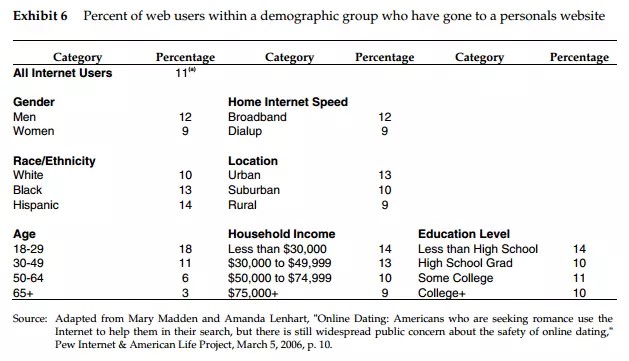Recommendation
The case of eHarmony can be described as mending something that was not broken to begin with. The emergence of new competitors, such as Match and its Chemistry will only serve as the foil for showcasing the site’s advantages: “Competition determines the direction a company must go to ensure value content in its goods or services” (Lindgreen et al. 207).
However, at present, the eHarmony site does not provide much space for extemporaneous conversations that is necessary for building relationships. While people’s need for planning, which the site caters to, is essential to creating a strong bond between partners, the owner of eHarmony fails to attract the attention of the people that might feel hesitant to starting long-term relationships. Since the category of the undecided users is extremely large, it will be reasonable to consider an option of adding an option of a custom profile for unregistered users (i.e., the ones, who have not provided their full data and answered all questions). Thus, the need to invest into the R&D factors in.
Support
eHarmony is the number one matching site worldwide, according to the case study details (Piskorski, Haraburda and Smith 139). Even the appearance of a new competitor, known as Match, has not disrupted the system of the company’s operations. At present, Match with its Chemistry site does not stand any comparison to eHarmony and its flexible system one could make a very slim argument about Match having a less rigid set of principles concerning the registration process: “On average, 5% of those who signed up became paying subscribers” (Piskorski, Haraburda and Smith 147). As Exhibit 6 shows, eHarmony does suffer from missed opportunities, seeing that the number of customer profiles listed in the company’s database is no longer increasing at the same steady pace as it used to (Piskorski, Haraburda and Smith 157).

In addition, Exhibit 3 displays quite clearly that the organization could use a better pricing system. eHarmony clearly needs to reconsider its pricing strategy, which may become possible with the invention of a custom profile for unregistered users. As a result, the organization may increase the charge for its features gradually, thus, increasing its “competitive real exchange rate” (Rapetti 2). The price for a standard profile that is not based on the essential information about the user’s personality may cost slightly cheaper Match charges its customers for, whereas the opportunities for a better matching process should be provided for an additional payment.
Thus, the company will prove that it operates on truly seminal principles, unlike Match, which provides a set of stock tools and does not invite a possibility for improving the quality of its services. It could also be suggested that the process of contacting the Support should be enhanced; an interactive chat similar to that one suggested for unregistered users should be viewed as an option.
Plan of Action
In general, the organization needs a major boost for its R&D and IT Departments so that new options for users could be added and the pricing policy should be altered and justified. It should be born in mind, though, that the inclusion of options for unregistered users may trigger slight changes in the company’s vision and mission. The latter two should be geared towards offering an opportunity of matching for anyone and inviting hesitant customers as well. The chat option mentioned above should be made available both as an addition to the user interface at the site and as a mobile application. As long as eHarmony is one step ahead of Match, it will retain its position as the most successful matching organization.
Works Cited
Lindgreen, Adam, Martin K. Hingley, David B. Grant and Robert E. Morgan. “Value in Business and Industrial Marketing: Past, Present, and Future.” Industrial Marketing Management 41.1 (2012), 207–214. Web.
Piskorski, Mikolaj Jan, Hanna Haraburda and Troy Smith. ”eHarmony.” Harvard Business School. 2008, July 1. 139–164. Print.
Rapetti, Martin. “Macroeconomic Policy Coordination in a Competitive Real Exchange Rate Strategy for Development.” Econstor 9.1 (2011), 1–32. Web.